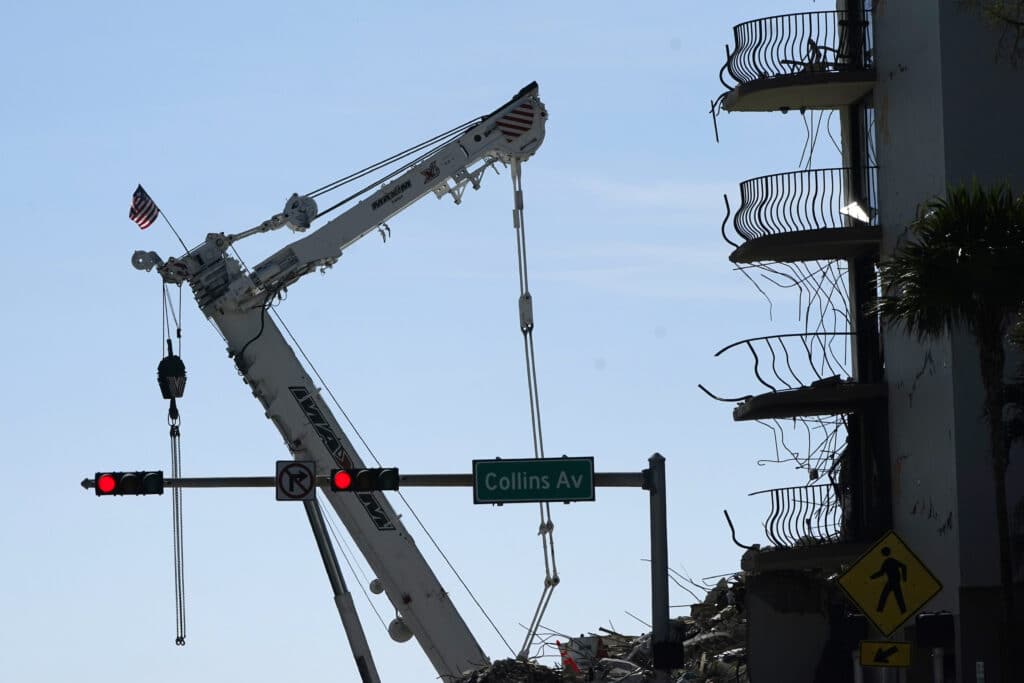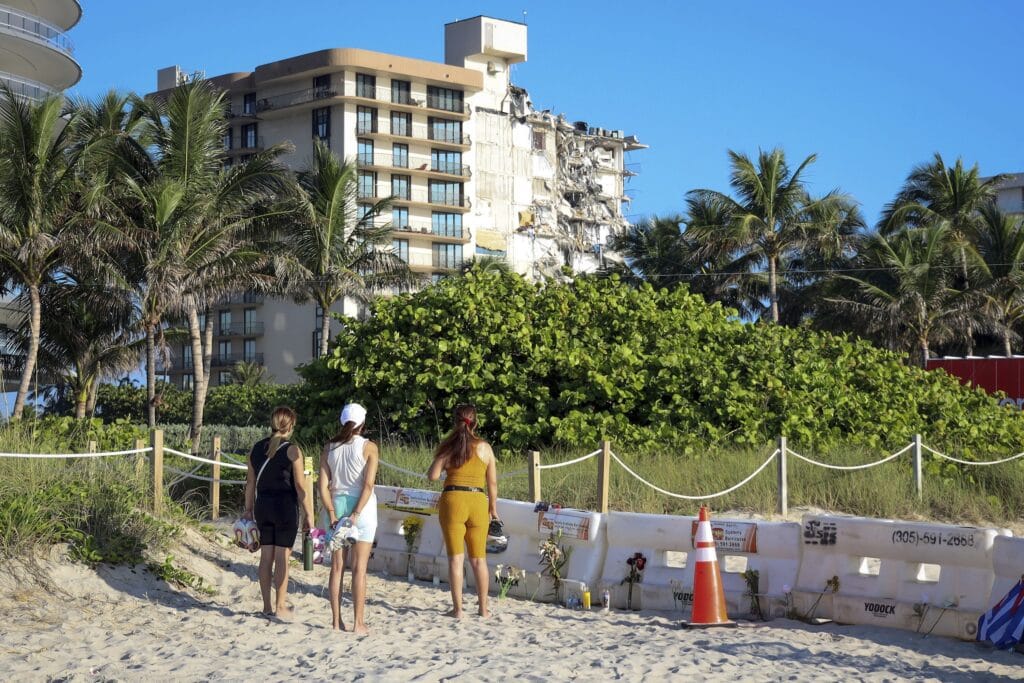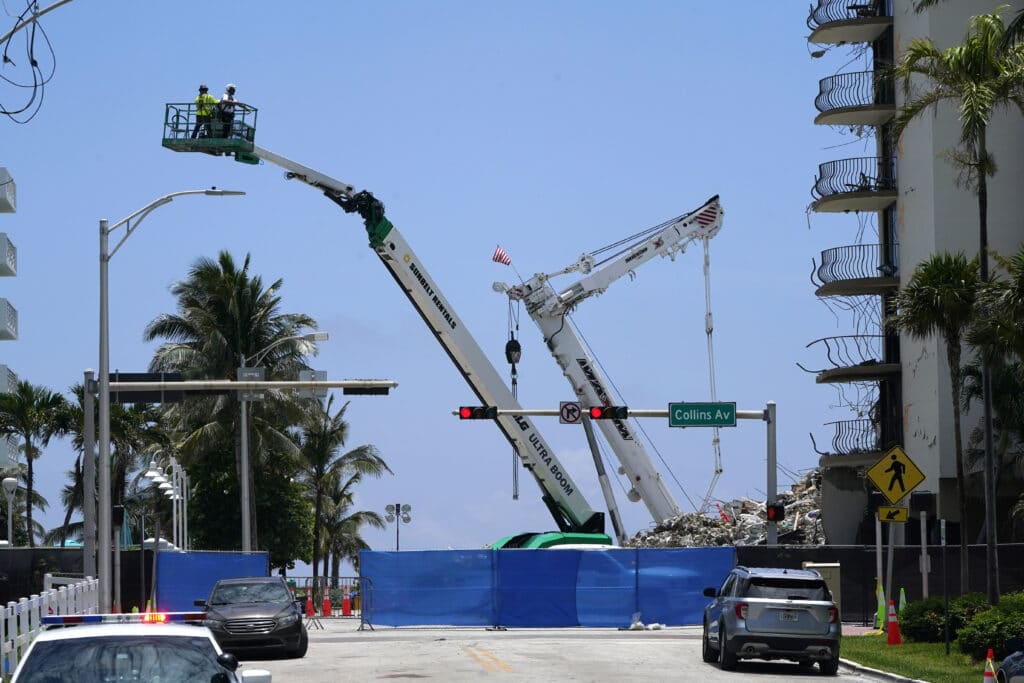The collapsed condo in Surfside, Florida is being demolished, and the process began with holes bored for explosive charges. The Associated Press has the story:
“Our top priority is that the building come down as soon as possible”
SURFSIDE, Fla. (AP) — Demolition specialists bored holes for explosive charges Sunday as they prepared to bring down the precarious but still-standing portion of a collapsed South Florida condo building. The work has suspended the search-and-rescue mission, but officials said it would eventually open up new areas for rescue teams to explore.

The decision to demolish the Surfside building came after concerns mounted that the damaged structure was at risk of falling, endangering the crews below and preventing them from operating in some areas.
“Our top priority is that the building come down as soon as possible, no matter what time that occurs and as safely as possible,” Miami-Dade County Mayor Daniella Levine Cava told a news conference Sunday. “Bringing down this building in a controlled manner is critical to expanding the scope of our search-and-rescue effort.”
Eighty percent of the drilling work was complete by Sunday morning, and the remaining structure could come down as soon as later that night, Miami-Dade Assistant Fire Chief Raide Jadallah told relatives of those missing in the collapse.

That timeline — faster than initially expected, though still not certain — drew applause from families eager for the search to restart. No one has been rescued alive since the first hours after the June 24 collapse.
The search at the Surfside building has been suspended since Saturday afternoon so workers could begin the drilling work. Jadallah said the suspension was necessary because the drilling could cause the structure to fail, but a family member could be heard calling that news “devastating.”
So far, rescuers have recovered the remains of 24 people, with 121 still missing. The Miami-Dade Police Department on Saturday night added Graciela Cattarossi, 48, and Gonzalo Torre, 81, to the list of those confirmed dead.
Once the structure is demolished, the remnants will be removed immediately with the intent of giving rescuers access for the first time to parts of the garage area that are a focus of interest, Jadallah has said. That could give a clearer picture of voids that may exist in the rubble and could possibly harbor survivors.
Officials began considering the demolition at Champlain Towers on Thursday when parts of the remaining building shifted, endangering rescuers and prompting a 15-hour suspension in their work.
Approaching Tropical Storm Elsa added urgency to those plans with forecasts suggesting strong winds could enter the area by Monday. The latest forecasts have moved the storm westward, mostly sparing South Florida, but National Hurricane Center meteorologist Robert Molleda said the area could still feel effects starting Monday.

“We’re expecting primarily tropical storm force gusts,” Molleda said, referring to gusts above 40 miles per hour (64 kph).
The detonation will aim to bring the remaining portion of the building straight down and toward the street side, away from the existing pile of debris, Jadallah said. Search-and-rescue efforts should resume between 15 and 60 minutes after the structure is brought down, he said.
The method of demolition is called “energetic felling,” which uses small detonation devices and relies on the force of gravity. Levine Cava said that brings the building down in place, containing the collapse to the immediate surroundings.
No one will be allowed in the buildings to the immediate north and south of the collapsed structure. Levine Cava advised other residents nearby to stay indoors during the demolition and close windows, doors and any other openings that could allow dust in.
Several officials acknowledged that the tragedy is continuing to unfold during the July 4th holiday.
“This is not an Independence Day like any we have ever experienced before,” said Levine Cava.
But she added: “Patriotism isn’t just about loyalty to country. It’s about loyalty to one another — to our communities, to those in need whose names or stories we may not know ever, but to whom we are connected by compassion and by resilience.”
By ADRIANA GOMEZ LICON and TERRY SPENCER






